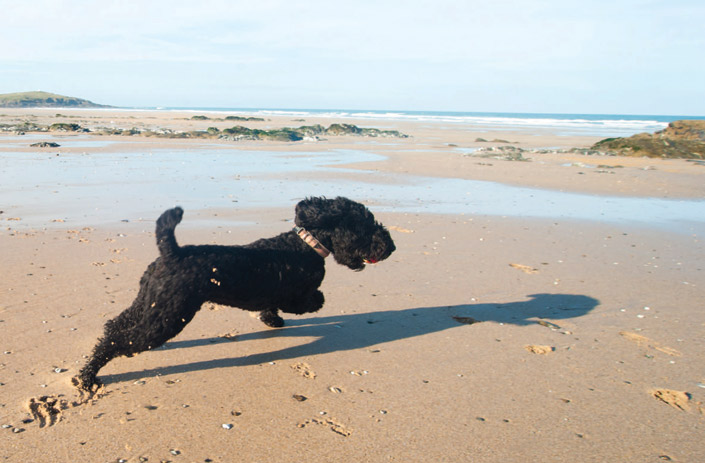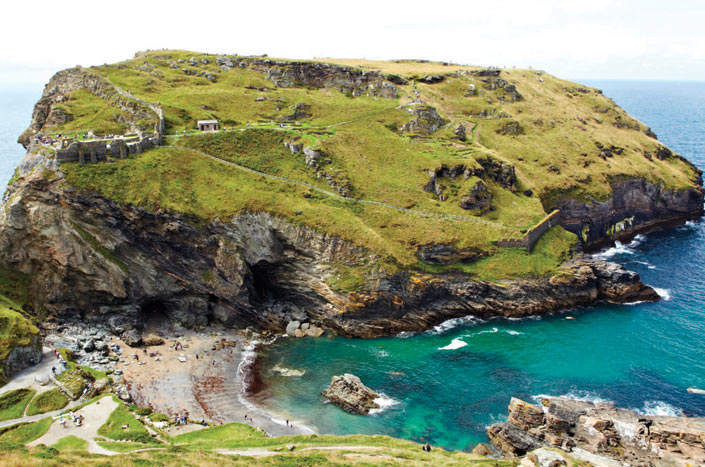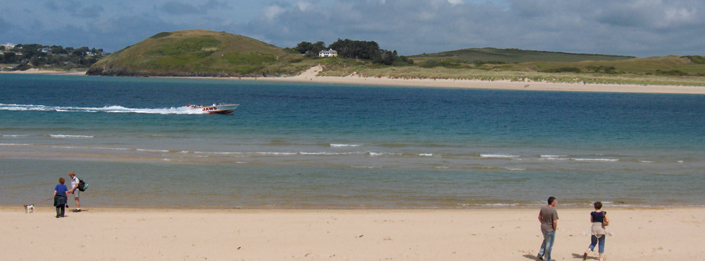There is no doubt that Cornwall is one of England’s most magical counties. The landscapes are stunning and rich in history.
There are over 400 miles of breathtaking coastline dotted with enchanting beaches and picture-postcard villages. And don’t forget the inviting wilderness of Bodmin Moor and the beautiful woodlands. From Arthurian legend and industrial heritage, to pasties and cream teas, the area is steeped in culture and tradition.
Best of all, Cornwall is a doggy haven. Dogs are welcomed with open arms at lots of beaches, pubs, cafes, hotels, and attractions. Taking a pet along with you is really the best way to discover Cornwall. So, what are you waiting for?
Dog-friendly days out and attractions in Cornwall
- The Lost Gardens of Heligan, Pentewan, St Austell — neglected after the First World War, the renowned gardens were restored to their former glory in the 1990s. Explore the enchanting gardens, which are home to rare and exotic plants, and the wider estate with its ancient woodlands and lakes, including a centre where you can watch footage of wildlife interacting across the estate. Dogs are permitted all year round but must be on a short lead. They are not permitted in the tea room or in the stewardry. For more information visit heligan.com or call 01726 845100.
- Cornish Seal Sanctuary, Gweek — as well as providing rescue for sick or injured seals, the centre is home to sea lions, otters, humboldt penguins, and even ponies, goats, and sheep. Visitors can watch the animals at feeding time, listen to talks by their keepers, and get up close to sea creatures during the interactive rockpool experience. A great family day out; dogs on leads are welcome but are not permitted on the land train or in the seal hospital. Visitors can get discounted tickets by booking on the website. For more information visit www.visitsealife.com/gweek or call 01326 221361.
- Bodmin Jail, Bodmin — for something a little different the jail is worth a visit. Built in 1779, the site gives an intriguing insight to crime and punishment over three centuries. Hear the bleak tales of past inmates and see the execution pit where some offenders were hanged. Some visitors report that the jail can be quite eerie and depressing so it may not be suitable for young children. Dogs are welcome around the attraction but are not permitted in the restaurant or wine bar. For more information visit www.bodminjail.org or call 01208 76292.
- Wheal Martyn, museum and country park, St Austell — the china clay industry has long been a part of Cornwall’s rich mining heritage. Visitors can learn about how the industry has developed from the Victorian era to the modern day. As well as a museum, the site is set in 26 acres of woodland and has a variety of trails to explore, which lead to a fantastic view over a working pit. Dogs are allowed everywhere except in the cafe, although there is undercover seating where owners can eat with their dogs. For more information visit www.wheal-martyn.com or call 01726 850362.
- Cornish castles — from coastal fortresses to imposing towers, the county has a host of dog-friendly castles. These include Launceston Castle, Pendennis Castle, St Mawes Castle, Restormel Castle, and St Catherine’s Castle. The highlight though is probably Tintagel Castle which is rumoured to have been where King Arthur was conceived. Dog owners can explore the coastal ruins and walk on the beach. It is possible to search for English Heritage sites using a dog-friendly fi lter on the website; visit www.englishheritage.org.uk
By sea or sky
- If you fancy a great doggy day trip, or even a longer break, why not take your dog to the Isles of Scilly? Tranquil, unspoilt, and full of culture, the isles lie just off mainland Cornwall. There are loads of great dog walks, plenty of dog-friendly accommodation, and even an annual dog show every June. To get to the isles your dog can travel with you by plane or ferry. Pets will need an approved carrier to travel by plane and are restricted to certain areas on the ferry. For more information visit www.islesofscilly-travel.co.uk or call 01736 334220.
Dog-friendly places to eat in Cornwall
- The Cornish Arms, St Merryn — owned by celebrity chef Rick Stein, this traditional Cornish pub serves a menu of British pub classics. Children of all ages are welcome and can try any of the dishes from the menu. Dogs on leads are allowed too — just ask at the bar for some treats for them to enjoy. There’s a popular pub garden too. Food is served from 12.30pm – 3pm and 5.30pm – 9pm. For more information visit www.rickstein.com/eat-with-us/the-cornish-arms or call 01841 532700.
- The Jamaica Inn, Launceston — a famous smuggling inn and the inspiration behind Daphne Du Maurier’s novel of the same name after the author stayed there in 1930. Today the inn is a popular stop-off to dine or stay, and there is a museum dedicated to smuggling. Pets are welcome to eat with you in the bar area, and stay in one of two dog-friendly rooms which have laminate flooring. The inn is supposedly haunted so do look out for ghosts! For more information visit www.jamaicainn.co.uk or call 01566 86250.

Dog-friendly beaches in Cornwall
From miles of golden sands to hidden coves, the selection of beaches is one of Cornwall’s star attractions. While some beaches operate seasonal bans, most allow dogs all year round; only a very small number do not permit dogs at all.
Dog-friendly places in Cornwall
- Mullion Cove Hotel, Mullion — the hotel was recently awarded five stars for dog friendliness in the Your Dog ‘Where to Stay’ guide 2015/16. Dogs receive a welcome pack on arrival and there is a dog-friendly lounge where owners can eat with their pets. Situated on the cliff top overlooking Mullion harbour, the hotel garden can be used to exercise dogs and the coastal footpath is also on the doorstep. The hotel is happy for dogs to be left alone in the rooms as long as owners remain on site. For more information visit www.mullion-cove.co.uk or call 01326 240328.
- Danescombe Mine, Calstock — the converted engine house of a former mine, this Landmark Trust property is an idyllic escape. Nestled in a wooded valley leading to the Tamar river near to the Devon border, the property is spread over three floors and sleeps up to four people. On the ground floor is the living room and kitchen, and a decking area where visitors can sit outdoors and listen to the sounds of the passing stream. The bedrooms and bathroom are on the upper floors. Owners can take up to two dogs on their tranquil getaway. For more information visit www.landmarktrust. org.uk or call 01628 825925.

Great places to visit
With every corner of Cornwall boasting stunning scenery and landscape it can be hard to decide which area to make your base for a holiday. If the sand and sea isn’t your cup of tea don’t despair - there’s more to Cornwall than just its beautiful coastal areas. In the heart of the county lies Bodmin Moor, a rugged landscape filled with forests, woodlands, waterfalls, and craggy tors - a walker’s paradise.
Let your imagination run wild by visiting sites in this area made famous by stories connected to the Knights Templar and King Arthur. Not far from Bodmin Moor, a few miles from the coast, is the market town of Liskeard, which provides a gateway to the moor.
The Atlantic coast of Cornwall, in the north of the county, stretches for more than 70 miles where visitors can find villages and towns huddled on cliffs. North Cornwall has much dramatic scenery; if you’re in the region it’s worth taking day trips to Newquay, Bude, and Padstow. For a slice of Cornish history Tintagel is not to be missed; climb dozens upon dozens of wooden steps taking you from the mainland to the island, where you can explore castle ruins on the cliff top. You’re guaranteed to find the perfect spot for some stunning photography. Travel a few miles from Tintagel and you’ll find Trebarwith Strand beach, which is dog friendly all year round.
Top dog destination
West Cornwall is visited by hordes of holidaymakers each year all eager to explore some of its most famous towns. St Ives has a unique art scene and offers plenty of activities for adults, children, and dogs, and is hailed as the ultimate year-round holiday destination. Penzance has a promenade, lots of shops, restaurants, cafés, and galleries. Take your dog for a walk along the beach at Marazion - open to dogs all year round - and venture towards St Michael’s Mount at low tide.
A visit to the west coast isn’t complete without a trip to Land’s End, especially if it’s your first time in Cornwall. This part of the county is abundant in cliff walks and hidden coves; visit Cape Cornwall and Sennen Cove for some energetic sightseeing.The south coast of Cornwall is full of contrasts and will provide plenty of surprises. Be sure to visit Falmouth, Fowey, Looe, and Truro. Of course, no trip to Cornwall would be complete without indulging in a traditional Cornish cream tea and Cornish pasty, so make this a must before heading home.

Sir John Betjeman Walk guide
Many people who visit Cornwall fall in love with the county. For poet Sir John Betjeman, his love affair with the area began as a young boy when he was holidaying in Trebetherick. He captured the wonder of the county in numerous poems, essays, and a TV programme. The former poet laureate moved to Cornwall and lived there until his death in 1984.
The South West Coast Path, which is a National Trail and runs along the whole of the Cornish coastline, has a circular walk called the Sir John Betjeman Walk. On this steady stroll you can take in some of the majestic landscapes that inspired the poet and visit his grave at St Enodoc church. You’ll also see Bronze Age burial mounds, a ruined Roman encampment, and meander along the coastline on to a dog-friendly beach. The gentle route makes for a great dog walk that you’ll probably love just as much as Betjeman did.
At a glance
Distance: 3.7 miles (6km).
Time: 21/2 hours.
Terrain: Easy walking that is mostly flat, along sandy grassland, and tarmac.
How to get there: The walk begins from the Rock Quarry car park (postcode PL27 6LD) in the fishing village of Rock, on Cornwall’s north coast. The village is situated on the banks of the River Camel, just off the B3314. Once you’ve left the B3314, join Rock Road and follow it all the way along the sea front at Rock; the car park is situated at the end of the road.
The route:
- Begin at the Rock Quarry car park. Take the path at the far end (the opposite end to where you drive in). Head through the dunes to pick up the South West Coast Path. There are many different paths leading off the route including a fork after about 200 metres. Bear left here and always stick to the South West Coast Path.
- After about half a mile you will approach Brea Hill. The summit is home to Bronze Age burial mounds which are up to 4,000 years old, and the remains of a Roman encampment. Carry on around the front of the hill, climbing over its lower slopes.
- The path heads round the shoreline before winding down to Daymer Beach which is dog friendly all year round. You can either walk across the sand or stick to the path until you reach the car park at the far end of the beach.
- Leaving the coast path, head inland on to Daymer Lane. Carry on up the street for a short distance until you come to a private road on your right with a footpath signposted for St Enodoc Church.
- Follow the lane between the houses on to a little footpath leading on to the heath. Continue on the path for about a quarter of a mile — ignoring all the other paths which cross or split from yours — until your see St Enodoc Church on your left. The church is named after Welsh hermit St Enodoc, who sailed to Cornwall to help Christians fight paganism around the fourth century.
- Bear left on the path to take a detour into the churchyard to see John Betjeman’s grave which is on the right just after the gate. There is plenty of seating so you can enjoy a stop-off and take in the views that inspired the poet.
- On leaving the graveyard, return to the path. Continue on to the footpathas it skirts the edge of the woods. Here you’re entering a golf course so beware of any stray balls!
- Continue on the route heading down the left-hand side of a large pond. Use the footbridge to head over the water following the tarmac path until it forks. Here you have a choice. For a shorter walk head right to pick up a waymarked route through the course to the golf club car park. Alternatively, bear left and continue along the tarmac trail for just over half a mile until the path reaches a junction. Take the small path to your left which leads to Jesus Well where Enodoc baptised his converts. The well is given its name because Jesus was said to have visited the area in his teens before journeying through Cornwall up to Glastonbury. Retrace your steps back to the junction, this time taking the path opposite you.
- Continue on the path, following it round as it takes a 90-degree turn to the right on to a road. Keep walking until you reach a crossroads. You’ll see the golf club car park on the right where those who took the shorter route will emerge. Turn left, heading down the street, until you reach Rock Road on the river front. Turn right and follow the road until you return to the car park where you began the walk.











